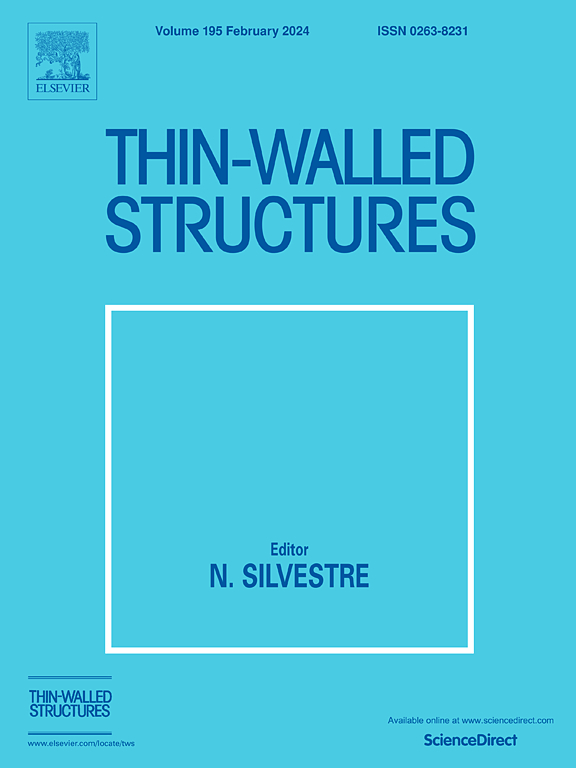Nonlinear static and dynamic responses of edge-cracked FG-GPLRC dielectric beams with internal pores
IF 5.7
1区 工程技术
Q1 ENGINEERING, CIVIL
引用次数: 0
Abstract
The dielectric properties of functionally graded (FG) graphene platelets (GPLs) reinforced composite (FG-GPLRC) beams enable tunable mechanical responses under external electric fields and hence offer an effective way for enhanced control of structural performance. This paper investigates nonlinear static and dynamic responses of FG-GPLRC dielectric beams with internal pores and an open edge crack. A two-step hybrid mechanical model is developed to determine the material properties of the multiphase composites. The governing equations, incorporating damping and dielectric properties, are derived within the framework of Timoshenko beam theory and the nonlinear von Kármán strain-displacement relationship. The stress intensity factor (SIF) at the crack tip of the cracked FG-GPLRC beam is obtained via finite element method (FEM). Differential quadrature (DQ) and incremental harmonic balance (IHB) methods combined with the arc-length algorithm methods are utilized to solve the nonlinear system. After the present analysis has been verified, a comprehensive parametric study is conducted to examine the effects of internal pore attributes, crack location and depth, damping, GPL properties and the applied electric field on the nonlinear bending, free and forced vibrations of the cracked FG-GPLRC beam. The study indicates that the internal pore attributes and crack location and depth have a significant impact on the nonlinear frequency, dimensionless amplitude, and peak amplitude excitation frequency of the cracked FG-GPLRC beam under an applied voltage.
带有内孔的边缘开裂 FG-GPLRC 介电梁的非线性静态和动态响应
功能分级(FG)石墨烯平板(GPLs)增强复合材料(FG-GPLRC)梁的介电特性可对外部电场产生可调的机械响应,因此为增强结构性能控制提供了有效途径。本文研究了具有内部孔隙和开放边缘裂缝的 FG-GPLRC 介电梁的非线性静态和动态响应。本文建立了一个两步混合力学模型,以确定多相复合材料的材料特性。在 Timoshenko 梁理论和非线性 von Kármán 应变-位移关系的框架内,导出了包含阻尼和介电特性的控制方程。开裂的 FG-GPLRC 梁裂缝顶端的应力强度因子(SIF)是通过有限元法(FEM)获得的。微分正交(DQ)和增量谐波平衡(IHB)方法与弧长算法方法相结合,用于求解非线性系统。本分析经过验证后,进行了全面的参数研究,以检验内部孔隙属性、裂缝位置和深度、阻尼、GPL 属性和外加电场对开裂 FG-GPLRC 梁的非线性弯曲、自由和强迫振动的影响。研究表明,内部孔隙属性、裂纹位置和深度对外加电压下开裂 FG-GPLRC 梁的非线性频率、无量纲振幅和峰值振幅激励频率有显著影响。
本文章由计算机程序翻译,如有差异,请以英文原文为准。
求助全文
约1分钟内获得全文
求助全文
来源期刊

Thin-Walled Structures
工程技术-工程:土木
CiteScore
9.60
自引率
20.30%
发文量
801
审稿时长
66 days
期刊介绍:
Thin-walled structures comprises an important and growing proportion of engineering construction with areas of application becoming increasingly diverse, ranging from aircraft, bridges, ships and oil rigs to storage vessels, industrial buildings and warehouses.
Many factors, including cost and weight economy, new materials and processes and the growth of powerful methods of analysis have contributed to this growth, and led to the need for a journal which concentrates specifically on structures in which problems arise due to the thinness of the walls. This field includes cold– formed sections, plate and shell structures, reinforced plastics structures and aluminium structures, and is of importance in many branches of engineering.
The primary criterion for consideration of papers in Thin–Walled Structures is that they must be concerned with thin–walled structures or the basic problems inherent in thin–walled structures. Provided this criterion is satisfied no restriction is placed on the type of construction, material or field of application. Papers on theory, experiment, design, etc., are published and it is expected that many papers will contain aspects of all three.
 求助内容:
求助内容: 应助结果提醒方式:
应助结果提醒方式:


